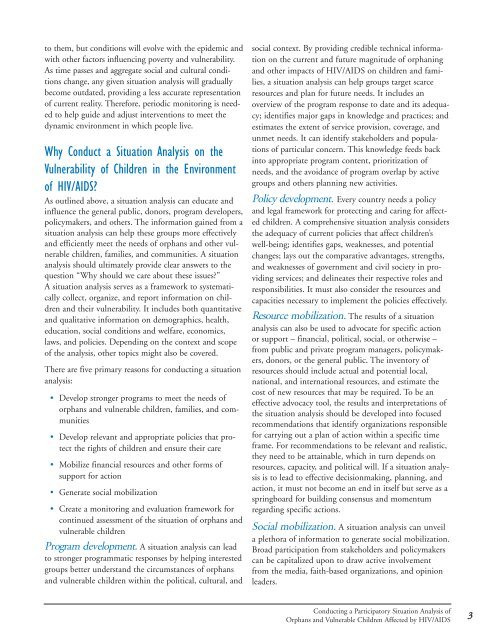Conducting a Participatory Situation Analysis of.pdf - Global HIV ...
Conducting a Participatory Situation Analysis of.pdf - Global HIV ...
Conducting a Participatory Situation Analysis of.pdf - Global HIV ...
Create successful ePaper yourself
Turn your PDF publications into a flip-book with our unique Google optimized e-Paper software.
to them, but conditions will evolve with the epidemic and<br />
with other factors influencing poverty and vulnerability.<br />
As time passes and aggregate social and cultural conditions<br />
change, any given situation analysis will gradually<br />
become outdated, providing a less accurate representation<br />
<strong>of</strong> current reality. Therefore, periodic monitoring is needed<br />
to help guide and adjust interventions to meet the<br />
dynamic environment in which people live.<br />
Why Conduct a <strong>Situation</strong> <strong>Analysis</strong> on the<br />
Vulnerability <strong>of</strong> Children in the Environment<br />
<strong>of</strong> <strong>HIV</strong>/AIDS?<br />
As outlined above, a situation analysis can educate and<br />
influence the general public, donors, program developers,<br />
policymakers, and others. The information gained from a<br />
situation analysis can help these groups more effectively<br />
and efficiently meet the needs <strong>of</strong> orphans and other vulnerable<br />
children, families, and communities. A situation<br />
analysis should ultimately provide clear answers to the<br />
question “Why should we care about these issues?”<br />
A situation analysis serves as a framework to systematically<br />
collect, organize, and report information on children<br />
and their vulnerability. It includes both quantitative<br />
and qualitative information on demographics, health,<br />
education, social conditions and welfare, economics,<br />
laws, and policies. Depending on the context and scope<br />
<strong>of</strong> the analysis, other topics might also be covered.<br />
There are five primary reasons for conducting a situation<br />
analysis:<br />
• Develop stronger programs to meet the needs <strong>of</strong><br />
orphans and vulnerable children, families, and communities<br />
• Develop relevant and appropriate policies that protect<br />
the rights <strong>of</strong> children and ensure their care<br />
• Mobilize financial resources and other forms <strong>of</strong><br />
support for action<br />
• Generate social mobilization<br />
• Create a monitoring and evaluation framework for<br />
continued assessment <strong>of</strong> the situation <strong>of</strong> orphans and<br />
vulnerable children<br />
Program development. A situation analysis can lead<br />
to stronger programmatic responses by helping interested<br />
groups better understand the circumstances <strong>of</strong> orphans<br />
and vulnerable children within the political, cultural, and<br />
social context. By providing credible technical information<br />
on the current and future magnitude <strong>of</strong> orphaning<br />
and other impacts <strong>of</strong> <strong>HIV</strong>/AIDS on children and families,<br />
a situation analysis can help groups target scarce<br />
resources and plan for future needs. It includes an<br />
overview <strong>of</strong> the program response to date and its adequacy;<br />
identifies major gaps in knowledge and practices; and<br />
estimates the extent <strong>of</strong> service provision, coverage, and<br />
unmet needs. It can identify stakeholders and populations<br />
<strong>of</strong> particular concern. This knowledge feeds back<br />
into appropriate program content, prioritization <strong>of</strong><br />
needs, and the avoidance <strong>of</strong> program overlap by active<br />
groups and others planning new activities.<br />
Policy development. Every country needs a policy<br />
and legal framework for protecting and caring for affected<br />
children. A comprehensive situation analysis considers<br />
the adequacy <strong>of</strong> current policies that affect children’s<br />
well-being; identifies gaps, weaknesses, and potential<br />
changes; lays out the comparative advantages, strengths,<br />
and weaknesses <strong>of</strong> government and civil society in providing<br />
services; and delineates their respective roles and<br />
responsibilities. It must also consider the resources and<br />
capacities necessary to implement the policies effectively.<br />
Resource mobilization. The results <strong>of</strong> a situation<br />
analysis can also be used to advocate for specific action<br />
or support – financial, political, social, or otherwise –<br />
from public and private program managers, policymakers,<br />
donors, or the general public. The inventory <strong>of</strong><br />
resources should include actual and potential local,<br />
national, and international resources, and estimate the<br />
cost <strong>of</strong> new resources that may be required. To be an<br />
effective advocacy tool, the results and interpretations <strong>of</strong><br />
the situation analysis should be developed into focused<br />
recommendations that identify organizations responsible<br />
for carrying out a plan <strong>of</strong> action within a specific time<br />
frame. For recommendations to be relevant and realistic,<br />
they need to be attainable, which in turn depends on<br />
resources, capacity, and political will. If a situation analysis<br />
is to lead to effective decisionmaking, planning, and<br />
action, it must not become an end in itself but serve as a<br />
springboard for building consensus and momentum<br />
regarding specific actions.<br />
Social mobilization. A situation analysis can unveil<br />
a plethora <strong>of</strong> information to generate social mobilization.<br />
Broad participation from stakeholders and policymakers<br />
can be capitalized upon to draw active involvement<br />
from the media, faith-based organizations, and opinion<br />
leaders.<br />
<strong>Conducting</strong> a <strong>Participatory</strong> <strong>Situation</strong> <strong>Analysis</strong> <strong>of</strong><br />
Orphans and Vulnerable Children Affected by <strong>HIV</strong>/AIDS<br />
3















